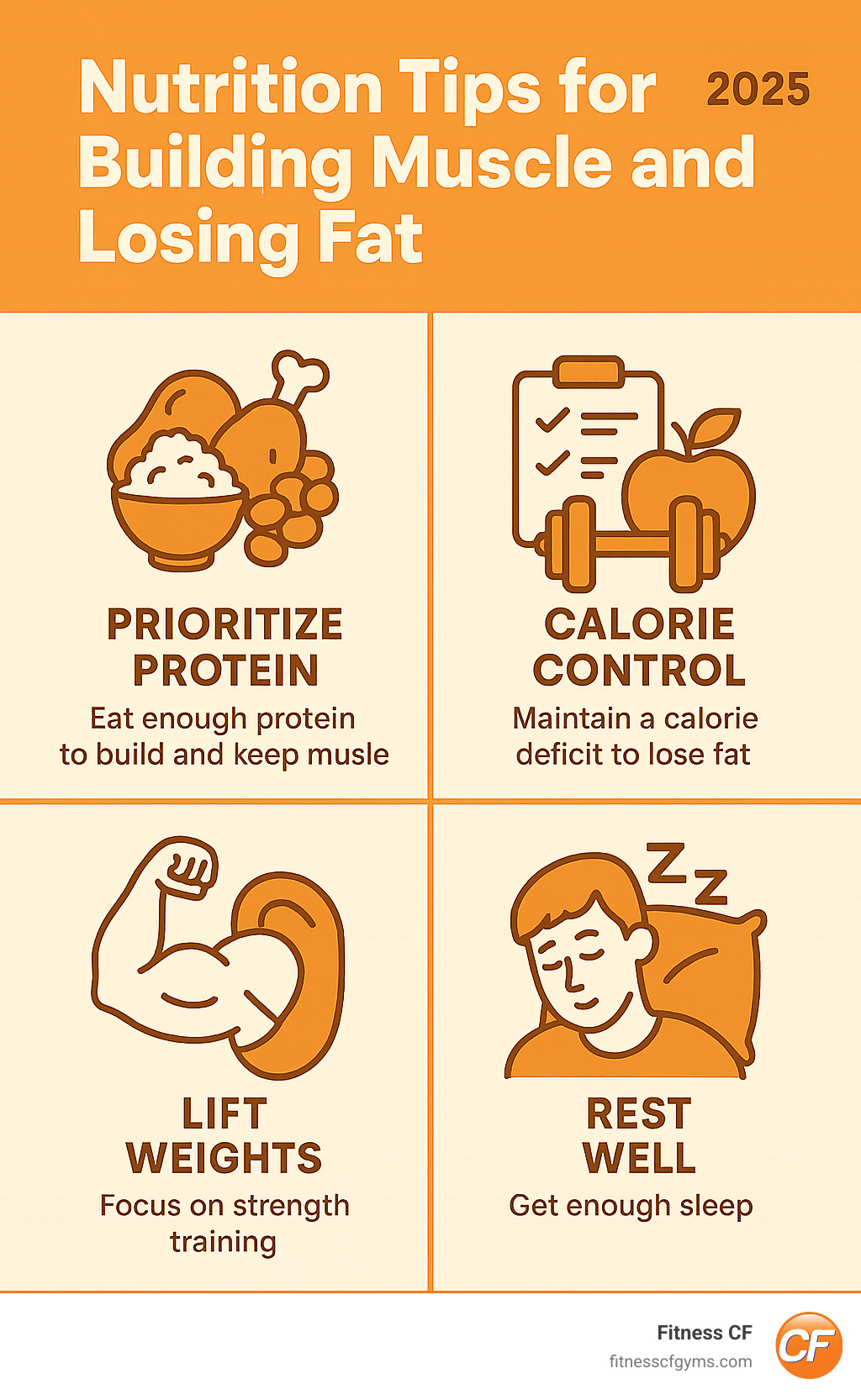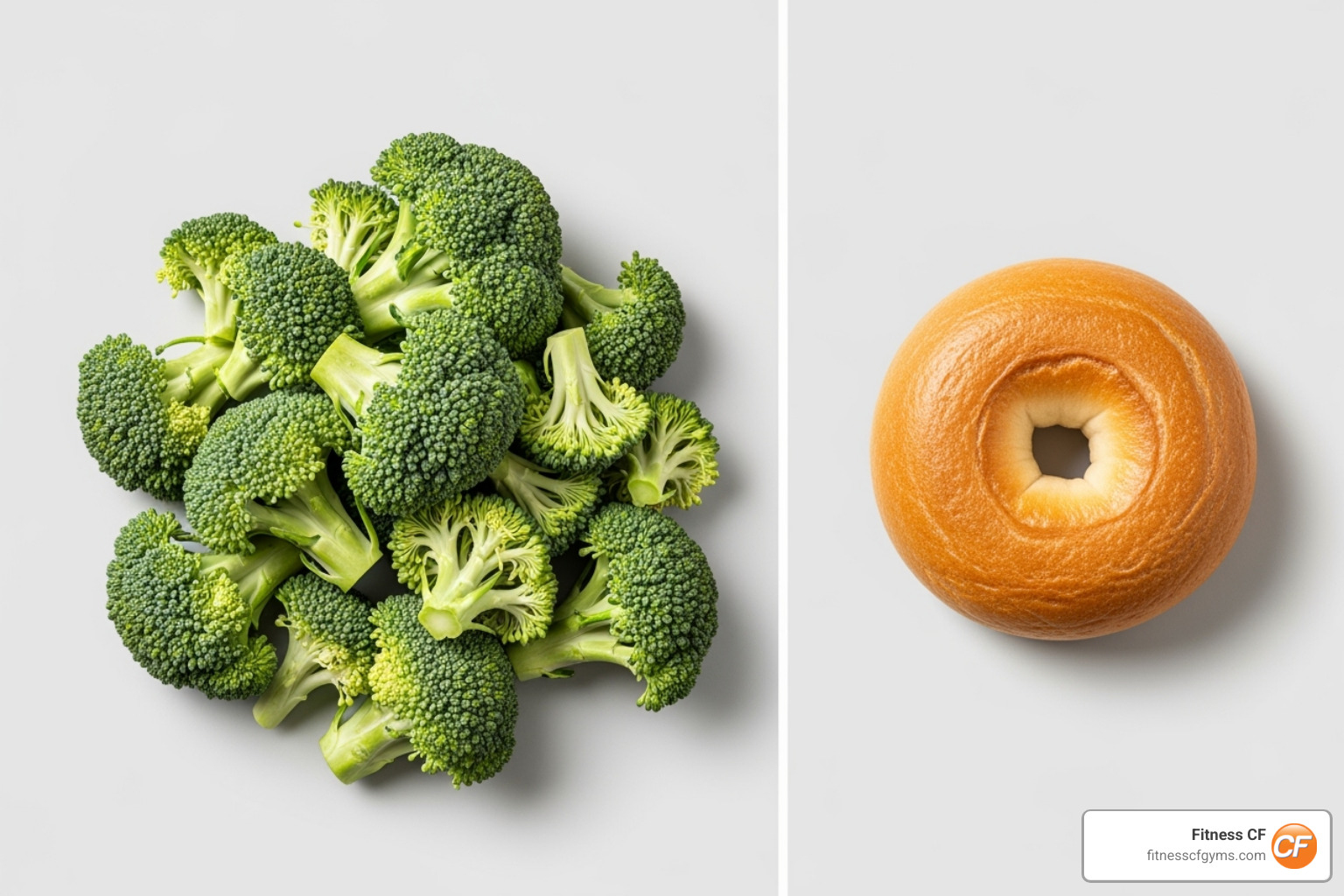The Smarter Way to Transform Your Body
Are you looking for nutrition tips for building muscle and losing fat? Here’s what matters most:
- Prioritize Protein: Eat enough protein to build and keep muscle.
- Calorie Control: Aim for a slight calorie deficit to lose fat.
- Lift Weights: Strength training tells your body to build muscle.
- Rest Well: Sleep helps your body recover and grow.
Forget the outdated idea that you can’t build muscle and lose fat simultaneously. This myth comes from old-school bodybuilding. As Adil Ahmed, MD, says, “I don’t care what the scale says or what your total weight loss is. It’s more about what your body is made of.”
This process, called body recomposition, focuses on changing your body’s shape, not just its weight. By building muscle while shedding fat, you create a healthier, more sustainable result. It’s an effective approach for nearly everyone, from beginners to seasoned athletes.
With over 40 years in the fitness industry, I’ve seen how effective these nutrition tips for building muscle and losing fat are. Let’s explore how you can achieve this change.

What is Body Recomposition?
Picture this: the scale hasn’t budged, but your clothes fit better and you look more toned. That’s body recomposition in action: building muscle while losing fat simultaneously.

Instead of just “losing weight,” this approach focuses on improving your body composition—the ratio of lean muscle to body fat—which is a far better indicator of health than the number on the scale.
Traditional weight loss often results in losing both fat and muscle. Losing muscle is counterproductive, as it’s your body’s metabolic engine, burning calories even at rest. A slower metabolism makes long-term weight management much harder.
Body composition is a better metric than BMI. BMI (Body Mass Index) only considers height and weight, failing to distinguish between muscle and fat. An athlete might have a “high” BMI but be very lean, while someone with a “normal” BMI could have low muscle mass, a condition sometimes called “skinny fat.”
The benefits of muscle are crucial for long-term health. After age 30, we naturally lose 3-5% of our muscle mass per decade. This age-related muscle loss, called sarcopenia, increases the risk of weakness, poor balance, and falls.
Muscle also protects bones and joints, supports your metabolism, and helps reduce inflammation. Focusing on nutrition tips for building muscle and losing fat is an investment in your long-term strength and vitality.
Body recomposition is a smarter, more sustainable fitness path. It ends the frustrating cycle of weight fluctuations by building a stronger, more efficient body.
Key Nutrition Tips for Building Muscle and Losing Fat
Nutrition is the cornerstone of body recomposition. While exercise signals the body to change, your diet provides the fuel to build muscle and lose fat. You can’t out-train a poor diet, but these nutrition tips for building muscle and losing fat are simple and effective.
Tip 1: Prioritize Protein to Fuel Muscle and Burn Fat
Protein is the most critical nutrient for changing your body composition. It provides the amino acids necessary to repair and build muscle after workouts. Without enough protein, especially in a calorie deficit, your body may break down muscle tissue instead of fat.
Protein is also highly satiating, meaning it keeps you feeling full longer, which helps control hunger and reduce overall calorie intake. Additionally, protein has the highest thermic effect of food, meaning your body uses more energy to digest it compared to fats and carbs, providing a slight metabolic boost.
For body recomposition, aim higher than the standard recommendation. Research suggests 1.5-2.0 grams of protein per kilogram (about 0.7-1 gram per pound) of body weight is optimal. A practical approach is to include 25-30 grams of protein in each meal. A diet high in protein can help facilitate fat loss, making this strategy even more valuable.
The best protein sources include chicken breast, lean beef, fish, eggs, and cottage cheese from animal sources, plus lentils, chickpeas, and tofu for plant-based options. Whey protein powder can be a convenient way to hit your targets. For a complete guide, check out our More info on a Lean Muscle Diet.
Tip 2: Maintain a Slight Calorie Deficit, Not a Drastic One
To lose fat, a calorie deficit is necessary, but a drastic one can backfire. Cutting calories too severely can cause your body to break down muscle for energy, which slows your metabolism and hinders long-term success.
A moderate deficit of 250-500 calories per day is ideal. This sustainable pace of 0.5-1 pound of fat loss per week helps preserve muscle mass. To find your target, calculate your maintenance calories and subtract 250-500. Food quality matters; 200 calories of nutrient-dense broccoli supports your body differently than 200 calories from a processed bagel.

For more strategies, explore our guide on Effective Weight Loss Strategies.
Tip 3: Strategically Time Your Nutrients for Better Results
While total daily intake is key, nutrient timing can provide an extra edge for performance and recovery.
Before your workout, consume carbohydrates like a banana or oats for energy. This fuel helps you train harder and stimulate muscle growth.
After your workout, a meal with protein and carbs is crucial. Protein begins muscle repair, while carbs replenish energy stores. Eating within a few hours of training supports optimal recovery. Eating every 3-4 hours also helps manage hunger and energy levels.
For detailed guidance, check out What to Eat After a Workout and The Role of Nutrition in Fitness.
Tip 4: Accept Quality Carbs and Healthy Fats
Carbohydrates and fats are just as important as protein for body recomposition.
Carbohydrates are your primary fuel for intense workouts. Choose complex carbs like oats, brown rice, and sweet potatoes for sustained energy. Avoid simple carbs that lead to energy crashes.
Healthy fats are vital for hormone production, which impacts muscle growth. Good sources include avocados, nuts, olive oil, and fatty fish like salmon. Aim for 20-35% of your calories from healthy fats.
Build your meals around whole foods. A balanced plate should include a lean protein source, colorful vegetables, complex carbohydrates, and healthy fats to fuel your body and keep you satisfied.
These nutrition tips for building muscle and losing fat are most effective when paired with consistent strength training and proper rest.
The Essential Role of Exercise in Body Recomposition
While nutrition tips for building muscle and losing fat provide the fuel, exercise provides the stimulus. Nutrition gives your body the raw materials, and exercise tells it to build muscle. Without strength training, a calorie deficit can lead to muscle loss. Combining smart nutrition with the right training is the key to body recomposition.
Focus on Strength Training for Muscle Growth
Strength training is non-negotiable for body recomposition. Lifting weights creates microscopic tears in muscle fibers, which your body then repairs and rebuilds stronger. This process, supported by research showing resistance training increases muscle strength and size, also boosts your metabolism. More muscle means more calories burned, even at rest.
Progressive overload is key to continued growth. This means gradually making workouts more challenging by adding weight, reps, or sets. A safe guideline is to increase weight by no more than 10% each week. Consistency is crucial, as research shows muscle mass can begin to decline after just five days of inactivity.
Compound exercises are the most efficient choice because they work multiple muscle groups simultaneously. Prioritize movements like squats, deadlifts, bench presses, overhead presses, and rows.
The CDC recommends strength training at least twice a week. For optimal muscle growth, aim for 10-20 sets per body part per week. Check out our guides: Vitality Through Strength Training and Best Strength Training Exercises to Add to Your Routine.
Incorporate Cardio for Heart Health and Fat Loss
Cardiovascular exercise plays a valuable supporting role in body recomposition when balanced with strength training. Cardio is essential for heart health, helping to reduce the risk of heart disease by strengthening your heart, improving circulation, and managing blood pressure and cholesterol. It also burns extra calories, which helps you create or maintain your calorie deficit and can accelerate fat loss.
You have two main options: High-Intensity Interval Training (HIIT), which involves short, intense bursts of effort, is time-efficient and burns calories long after the workout. Low-Intensity Steady-State (LISS), like brisk walking or cycling, is gentler on the body and easier to recover from. Learn more about The Benefits of HIIT.
Finding the right balance is key. Too much cardio can hinder muscle recovery, while too little may slow fat loss. For more guidance, explore Finding Balance: Combining Strength Training and Cardiovascular Exercise. The best routine is one you can stick with consistently.
Beyond the Plate: Lifestyle Factors That Drive Results
Beyond the powerful nutrition tips for building muscle and losing fat and exercise, certain lifestyle factors are critical for success. These “behind-the-scenes” habits play a huge role in your results.
Prioritize Sleep for Optimal Recovery and Hormone Balance
Sleep is one of the most underrated tools for body change. During sleep, your body performs critical repair and growth functions:
- Muscle Repair & Growth: Your body releases growth hormone during sleep, which is essential for repairing muscle tissue damaged during exercise and building new muscle.
- Hormone Balance: Lack of sleep increases cortisol, a stress hormone that promotes fat storage and muscle breakdown. Quality sleep helps regulate cortisol and supports healthy testosterone levels, which are vital for muscle building.
- Proven Results: Studies show that sleep-deprived individuals lose more muscle and less fat when dieting compared to those who get adequate rest.
Aim for 7-9 hours of quality sleep per night. This will improve your energy, mood, and overall results.
Manage Stress to Prevent Muscle Breakdown
Chronic stress can sabotage your body recomposition goals by elevating levels of the hormone cortisol.
- Muscle Loss & Fat Gain: High cortisol levels can lead to muscle breakdown and increased fat storage, particularly around the abdomen.
- Slowed Recovery: Stress impairs your body’s ability to recover from workouts, increasing fatigue and the risk of overtraining.
Find effective stress management techniques that work for you, such as:
- Mindfulness and meditation
- Gentle movement like yoga or walking
- Spending time in nature
- Engaging in hobbies and connecting with loved ones
Stay Hydrated for Peak Performance
Proper hydration is another simple but essential component of body recomposition.
- Nutrient Transport: Water is crucial for transporting nutrients like amino acids to your muscle cells and flushing out metabolic waste.
- Performance: Even mild dehydration can decrease strength, increase fatigue, and negatively impact the hormones that regulate muscle growth.
- Metabolism: Water is involved in numerous metabolic processes, including fat metabolism.
Aim for at least 8 glasses (about 2-3 liters) of water per day, adjusting for activity level and climate. Sip consistently throughout the day.
How to Track Your Progress Beyond the Scale
The scale can be misleading during body recomposition. As you build dense muscle and lose fat, your weight may stay the same or even increase. The scale doesn’t tell the whole story. Relying solely on weight can be demotivating, so here are smarter ways to track your progress:
- Progress photos taken every 4-6 weeks are a powerful visual tool. They reveal changes in muscle definition and body shape that the scale can’t show.
- Use a tape measure for body measurements. Tracking your waist, hips, chest, and arms can confirm you’re losing fat and gaining muscle, even if your weight is stable.
- Tracking strength gains is another excellent indicator. Lifting heavier weights, doing more reps, or improving your form are clear signs of progress. Keep a workout journal to monitor your improvements.
- Pay attention to how you feel. Increased energy, better-fitting clothes, and improved confidence are all significant markers of success.
- For more precise data, consider body fat percentage assessments like DEXA scans, which provide a detailed breakdown of your lean mass versus fat mass.
Using a combination of these methods provides a more accurate and motivating picture of your progress than the scale alone. For more insights, check out our article on The Myths and Facts About Spot Reduction.
Frequently Asked Questions about Nutrition for Building Muscle and Losing Fat
Here are answers to common questions about body recomposition and nutrition tips for building muscle and losing fat.
How long does body recomposition take?
Body recomposition is a slow process, not a sprint. It’s a sustainable lifestyle change that takes months or even years to yield significant results. The timeline varies based on several factors:
- Starting Point: Beginners and those with higher body fat may see faster initial results.
- Training Experience: “Newbie gains” allow new lifters to build muscle more quickly.
- Consistency: Adherence to your nutrition and training plan is crucial.
- Calorie Deficit: A smaller deficit favors muscle preservation but slows fat loss.
Patience and consistency are your most important tools.
Can beginners build muscle and lose fat at the same time?
Yes, beginners are in an ideal position to build muscle and lose fat simultaneously, a phenomenon often called “newbie gains.” A body unaccustomed to resistance training responds rapidly, allowing for muscle growth even in a calorie deficit. This also applies to individuals returning to training after a long break. While more challenging for experienced lifters, it’s still possible with a meticulous approach. Body recomposition is achievable at any fitness level.
What are the biggest mistakes to avoid?
When following nutrition tips for building muscle and losing fat, avoid these common mistakes to ensure progress:
- Cutting Calories Too Drastically: This can lead to muscle loss and a slower metabolism. Stick to a moderate, sustainable deficit.
- Not Eating Enough Protein: Inadequate protein intake prevents muscle repair and growth, especially in a deficit. Prioritize protein at every meal.
- Overtraining and Under-recovering: Pushing too hard without adequate rest leads to burnout and injury, halting progress. Listen to your body and prioritize recovery.
- Neglecting Sleep: Poor sleep disrupts hormones, slows muscle repair, and hinders progress. Aim for 7-9 hours nightly.
- Relying on Unproven Supplements: Most fat-loss or muscle-gain supplements are ineffective. Focus on the fundamentals: nutrition, training, and sleep. Only a few, like creatine and protein powder, are backed by strong evidence. Consult a healthcare professional before taking new supplements.
- Having Unrealistic Expectations: This is a long-term process. Avoid comparing yourself to others and focus on consistent, daily improvements.
For a comprehensive guide on avoiding common errors, check out 11 Common Muscle Building Mistakes and How to Avoid Them.
Conclusion: Building a Sustainable and Healthy Lifestyle
Applying these nutrition tips for building muscle and losing fat is about more than changing your appearance; it’s about building a foundation for lifelong health. It’s an investment in your future self.
We’ve covered the essentials: prioritizing protein, maintaining a slight calorie deficit, timing nutrients, and embracing quality carbs and healthy fats. Combined with foundational strength training, these strategies create the blueprint for change.
Lifestyle factors are equally critical. Quality sleep, stress management, and proper hydration are essential components of your success.
After four decades in the fitness industry, I can confirm that body recomposition is a lifestyle approach centered on consistency over perfection. It’s about making good choices most of the time and being resilient when you slip up.
The process may feel slow, but your body is building metabolically active muscle that improves strength, energy, bone health, and reduces disease risk. You’re building a healthier future.
Every healthy choice is an investment in a stronger, more confident you. The results—from increased strength to improved vitality—are well worth the effort.
Ready to start your change? We’re here to guide and support you every step of the way. Get started on your fitness journey with us and find what your body is truly capable of achieving.









